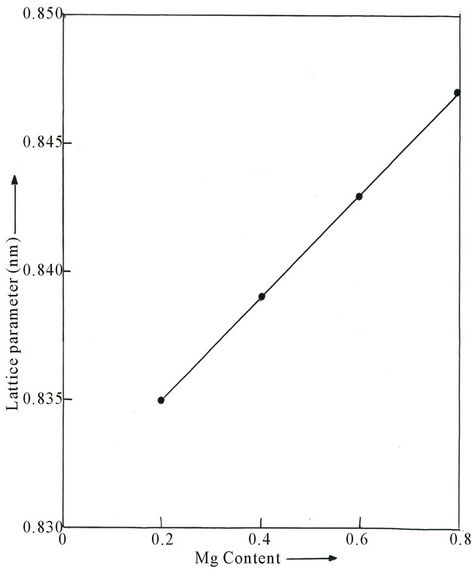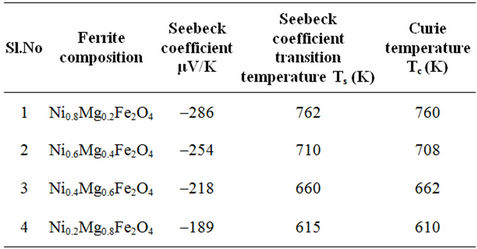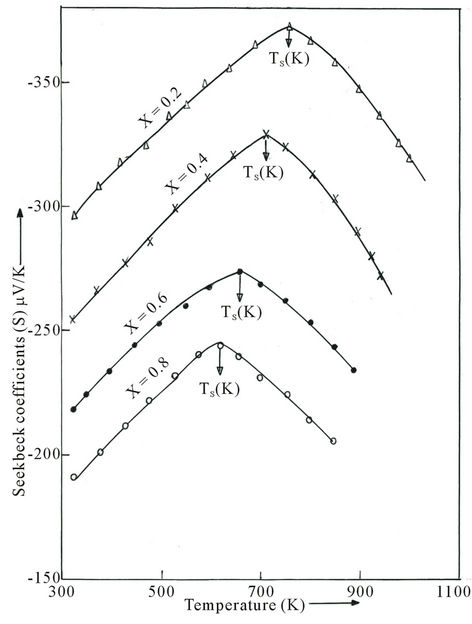World Journal of Condensed Matter Physics
Vol. 2 No. 4 (2012) , Article ID: 25042 , 4 pages DOI:10.4236/wjcmp.2012.24040
High-Temperature Thermoelectric Power Studies of Ni-Mg Ferrites
![]()
Department of Physics, Osmania University, Hyderabad, India.
Email: *ravindergupta28@rediffmail.com
Received March 8th, 2012; revised April 11th, 2012; accepted April 25th, 2012
Keywords: Electrical Properties; Sintering; Thermoelectric Power; Ni-Mg Ferrites
ABSTRACT
Thermoelectric Power studies of Ni-Mg ferrites having chemical formula Ni1–xMgxFeO4 (x = 0.2, 0.4, 0.6 and 0.8) were investigated from room temperature to well beyond Curie temperature by the differential method. The Seebeck coefficient is negative for all the composition. It clearly speaks that all the considered ferrite compositions behave as n-type semiconductors. Plots of Seebeck coefficient (S) versus temperature shows maximum at Curie temperature. The values of the charge carrier concentration have been computed from the observed values of Seebeck coefficient. The electrical properties of the Ni-Mg mixed ferrites have been measured at room temperature by two-probe method. On the basis of these results an explanation for the conduction mechanism in Ni-Mg mixed ferrites is suggested.
1. Introduction
Hall effect and thermoelectric power studies are widely used in the interpretation of the conduction mechanism in semiconductors. The result of interpretation of Hall effect reveals more straight forwarding precise results. However, in the case of low mobility semiconductors such as ferrites, it is sometimes difficult to measure the Hall effect, in such cases the study of thermoelectric measurements is the only alternative. Moreover the measurement of thermo-e.m.f. is simple and its sign gives vital information about the type of conduction in semiconductor whether they are n-type or p-type. Magnesium substituted ferrites have been used in many electronic devices for high frequency because of their high electrical resistivity, high Curie temperature and low cost.
The dielectric properties of Ni-Mg ferrites have been studied in detail [1]. As per author’s knowledge no information is available on thermometric power studies of mixed Ni-Mg ferrites in the literature. Moreover, there is a need for a thorough study of thermoelectric power studies of magnesium substituted nickel ferrites as a function of composition and temperature. The results of such a study are presented in this paper.
2. Experimental Details
2.1. Sample Preparation
The polycrystalline magnesium substituted Nickel ferrites having the compositional formula Ni1–xMgxFeO4 (x = 0.2, 0.4, 0.6 and 0.8) were prepared by double sintering ceramic method and the samples are annealed at 800˚C for 5 hr. Final sintering of the specimens was carried out at 1200˚C for 5 hr, the sintering atmosphere was being air. The details of the method of the preparation have been given in earlier publication [2].
2.2. Measurements
The Seebeck coefficients were measured by a differential method [3,4] from room temperature to well beyond Curie temperature. The temperature gradient across the sample was measured using two pairs of copper constantan thermocouples. The sample was mounted on top of two well-separated copper blocks with silver paint. The temperature difference between two ends of the sample was kept at 10˚C throughout the measured temperature range. To eliminate the effects of the reference leads, the absolute thermoelectric power of Cu was subtracted from the measured thermoelectric voltage. A Keithly 181 nano voltmeter was used for the voltage measurements.
The thermoelectric power or Seebeck coefficient (S) was calculated using the relation

where ∆E is the thermo e.m.f. produced across the sample due to the temperature difference ∆T. The electrical conductivity of the samples has been measured at room temperature by two-probe method [5] using a Kiethly electrometer model 6517A. The electrical conductivity (σ) of the Ni-Mg ferrites under investigation has been computed using the formula,

where I is the current passing through the specimen in amperes, V is the voltage applied to the specimen in volts, t is the thickness of the sample in centimeters and A denotes the area of sample in square centimeters. The Curie temperature Tc of the sample was determined by gravity method [6].
3. Results and Discussions
3.1. Composition Dependence of Lattice Parameter
X-ray diffraction patterns for all ferrites under investigation have been obtained using Cukα radiation of Rigaku DMAX II X-ray diffractomer. The lattice parameter of the mixed ferrites was calculated from d-spacing values. The variation in the lattice parameter with magnesium content is shown in Figure 1. It can be seen from the figure that the lattice parameter varies linearly with the magnesium ion content. A similar linear variation has also been observed in Zn-Mg-Cu [7] and Co-Zn [8] ferrites.

Figure 1. Variation of lattice parameter with magnesium content.
3.2. Composition Dependence of Seebeck Coefficient
The value of Seebeck coefficient (S) at 310 K computed from the measured values of thermo-e.m.f. is given in the Table 1. It can be seen from the table that the sign of Seebeck coefficient is negative for the Ni-Mg ferrites. On the basis of its negative sign, the magnesium substituted Nickel ferrites have been classified as n-type semiconductors. It can also be seen from the table that the value of Seebeck coefficient varies from −189 to −286 μV/K as the magnesium content increases from 0.2 to 0.8 moles.
3.3. Temperature Dependence of Thermoelectric Power
The variation of the thermoelectric power (S) with temperature is shown in the Figure 2. It can be seen from the figure that the value of thermoelectric power for all Ni-Mg ferrites increases with increasing temperature up to a certain temperature, which is designed as Ts (K). However, beyond this temperature the value of S starts decreasing with increasing temperature. The negative value of thermoelectric power found over the entire temperature range studied shows that the majority charge carriers are electrons. A similar variation of thermoelectric power with temperature was observed in Mg-Cr [9] and Lithium ferrites [10]. The values Ts(K) for each composition are given in the Table 1. The Curie temperature Tc(K) values are also included in table for comparison. It can be seen from the table that the values Ts (K) and Tc(K) are close, thereby indicating that the change in the behavior of the thermoelectric power with temperature may be due to magnetic transition, where the material becomes the paramagnetic. Thus, it is clear that in case of Ni-Mg ferrites the non-magnetic property under study (thermoelectric power) is exhibiting a clear-cut and well-defined transition at the Curie temperature, like the magnetic property such as susceptibility, permeability and spontaneous magnetization. The value of thermoelectric power is maximum at Tc(K). This clearly indicates

Table 1. Thermoelectric power data on mixed Ni-Mg ferrites.

Figure 2. Plot of Seebeck coefficient (S) versus temperature for mixed Ni1–xMgxFe2O4 Ferrites.
that the magnetic ordering has a marked influence on the thermoelectric property of these ferrite samples.
The variation of the Curie temperature Tc(K) with magnesium composition is shown in Figure 3. It can be noted from the figure that the value of Tc(K) decreases with increase of magnesium content. The decrease of Curie temperature with increase of magnesium content can be explained on the basis of the number of magnetic ions present in the two sub-lattices and their mutual interactions. As Fe3+ ions are gradually replaced by magnesium ions, the number magnetic ions being decrease at both sides, which also weakens the strength of AB exchange interactions of the type FeA3+-O2–-FeB3–. Thus the thermal energy required to offset the spin alignment decrease, thereby decreasing the Curie temperature. A similar decrease of the Tc(K) with the composition was also observed by Zaki [11] in case of Mg-Zn ferrites and Ravinder and Latha in Mn-Zn [12] ferrites.
3.4. Composition Dependence of Electrical Conductivity (σ), Carrier Concentration (n) and Mobility (μ)
Table 2 gives the experimental values of electrical conductivity and Seebeck coefficient values at room temperature. The carrier concentration for these ferrites was

Figure 3. Variation of Curie temperature Tc(K) with composition.

Table 2. Electrical transport data of Ni-Mg ferrites.
calculated using formula given by Morin and Gebella [13] and are rough estimated based on a simple 2 band model.

where S is Seebeck coefficient, e is charge of electron, K is Boltzmann constant and N is density of states or concentration of electronic levels involved in the conduction process.
The computed values of carrier concentration are included in Table 2. It can be seen from the table that the values of electrical conductivity decrease with the increase of magnesium content. This observation is in agreement with the reported by Rezlescu et al. [14] who found the resistivity of Li-Zn increases with increase of zinc content. Among all the ferrites the specimen with composition Ni0.2Mg0.8Fe2O4 has a minimum value for the Seebeck coefficient and a minimum value for the carrier concentration.
The mobility (μ) of the charge carriers was calculated from the experimental values of the electrical conductivity (σ) and carrier concentration (n)

The values of the charge carrier mobility for the different composition are also included in the Table 2. It can be seen from the table that the specimen with the composition Ni0.8Mg0.2Fe2O4 exhibits the highest value of charge carrier mobility.
4. Conclusion
In the present investigation Ni-Mg ferrites are classified as n-type semiconductors. Among all the ferrites the specimen with composition Ni0.2Mg0.8Fe2O4 exhibits the lowest value of Seebeck coefficient. This composition will be useful for technical application where low value of Seebeck coefficient material is required.
5. Acknowledgements
The authors are grateful for Prof. P. Kistaiah, Head, Department of Physics Osmania University, Hyderabad for his encouragement in research work.
REFERENCES
- J. Berchmans, R. Kalaiselvan, P. N. Selva Kumar and C. O. Augustin, “Structural and Electrical Properties of Ni1−xMgxFe2O4 Synthesized by Citrate Gel Process,” Journal of Magnetism and Magnetic Materials, Vol. 279, No. 1, 2004, pp. 103-110. doi:10.1016/j.jmmm.2004.01.073
- Dr. D. Ravinder and T. Seshagiri Rao, “Electrical Conductivity and Thermoelectric Power of Lithium-Cadmium Ferrites,” Crystal Research and Technology, Vol. 25, No. 8, 1990, pp. 963-969. doi:10.1002/crat.2170250820
- Z. Simsa, “Czech,” Journal of Physics B, Vol. 16, 1996, pp. 919-921.
- V. D. Reddy, M. A. Malik and P. V. Reddy, “Electrical Transport Properties of Manganese-Magnesium Mixed Ferrites,” Materials Science and Engineering B, Vol. 8, No. 4, 1991, pp. 295-301. doi:10.1016/0921-5107(91)90050-6
- V. R. K. Murthy and J. Sobhanadri, “Electrical Conductivity of Some Nickel-Zinc Ferrites,” Physica Status Solidi, Vol. 38, No. 2, 1976, pp. 647-651. doi:10.1002/pssa.2210380227
- D. Ravinder, “Electrical Properties of Lithium-Zinc and Lithium-Cadmium Ferrites,” Thesis, Osmania University, Hyderabad, 1988.
- S. M. Yunus, H. S. Shim, C. H. Lee, M. A. Asgar, F. U. Ahmed and A. K. M Zakaria, “Neutron Diffraction Studies of the Diluted Spinel Ferrite ZnxMg0.75−xCu0.25Fe2O4,” Journal of Magnetism and Magnetic Materials, Vol. 232, No. 3, 2001, pp. 121-132. doi:10.1016/S0304-8853(01)00224-4
- A. V. Ramana Reddy, G. Ranga Mohan, D. Ravinder and B. S. Boyanov, “High-Frequency Dielectric Behaviour of Polycrystalline Zinc Substituted Cobalt Ferrites,” Journal of Materials Science, Vol. 34, 1999, pp. 3169-3176.
- P. P. Hankar, V. T. Vady , U. B. Sankpau, L. V. Gavail, R. Sasikala and I. S. Mulla, “Effect of Sintering Temperature and Thermoelectric Power Studies of the System MgFe2−xCrxO4,” Solid State Sciences, Vol. 11, 2009, pp. 2075-2079.
- T. E. Whall, N. Salerno, Y. G. Proykova, K. A. Misza and S. Mazen, Philosophical Magazine, Vol. 53, 1986, pp. L107-L111.
- Zaki, “The Influence of Zn Ions Substitution on the Transport Properties of Mg-Ferrite,” Physica B, Vol. 404, 2009, pp. 3356-3362.
- D. Ravinder and K. Latha “Electrical Conductivity of Mn-Zn Ferrites,” Journal of Applied Physics, Vol. 75, No. 10, 1994, pp. 6118-6120. doi:10.1063/1.355479
- F. J. Morin and T. H. Gebella, “Electrical Conductivity and Seebeck Effect in Ni0.80Fe2.20O4,” Physical Review, Vol. 99, No. 2, 1955, pp. 467-498. doi:10.1103/PhysRev.99.467
- N. Rezlescu, D. Condurhach, P. Petairu and E. Luca, “Resistivity and Curie Point of Li-Zn Ferrites,” Journal of the American Ceramic Society, Vol. 57, No. 1, 1974, p. 40. doi:10.1111/j.1151-2916.1974.tb11360.x
NOTES
*Corresponding author.

